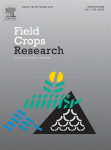Ver ítem
- xmlui.general.dspace_homeCentros Regionales y EEAsCentro Regional Buenos Aires SurEEA Hilario AscasubiArtículos científicosxmlui.ArtifactBrowser.ItemViewer.trail
- Inicio
- Centros Regionales y EEAs
- Centro Regional Buenos Aires Sur
- EEA Hilario Ascasubi
- Artículos científicos
- Ver ítem
Development and validation of a simulation model for hairy vetch (Vicia villosa Roth) self-regeneration under different crop rotations
Resumen
Hairy vetch (HV, Vicia villosa Roth) is a winter annual legume cultivated for pasture grazing, in crop rotations with cereal crops under semi-arid conditions. The inclusion of HV increases soil nitrogen, thus contributing to satisfied the nutrient requirements of the successive crops. As a forage crop, HV shows a remarkable capability for natural reseeding. This study aimed to develop and validate a simulation model to evaluate HV self-regeneration
[ver mas...]
Hairy vetch (HV, Vicia villosa Roth) is a winter annual legume cultivated for pasture grazing, in crop rotations with cereal crops under semi-arid conditions. The inclusion of HV increases soil nitrogen, thus contributing to satisfied the nutrient requirements of the successive crops. As a forage crop, HV shows a remarkable capability for natural reseeding. This study aimed to develop and validate a simulation model to evaluate HV self-regeneration capacity considering different HV–winter cereal crop rotation (pasture-crop phase) scenarios. Predicted HV plant density for the evaluated crop sequences matched observed values. HV yield and seed rain were the most important variables affecting seedbank replenishment and self-regeneration capacity. HV monoculture permits successive natural reseeding to reach a basal stand threshold of 30 plants m−2, required for a productive pasture. In a HV-cereal-HV crop rotation, the HV self-regeneration capacity requires a minimum seed yield of 185 and 240 kg ha−1 at the end of the first season under conventional (CT) and no tillage (NT) systems, respectively. Natural seedbank replenishment would not be enough to establish a productive pasture by self-regeneration after two or more successive years of cereals. From a weed management perspective, HV control should not be a considerable problem as a “volunteer plants” if management practices avoid seed production and seedbank replenishment for at least three consecutive years. These outcomes suggest the potential applicability of the proposed modelling approach within management decision support systems.
[Cerrar]

Autor
Renzi Pugni, Juan Pablo;
Chantre Balacca, Guillermo Ruben;
González-Andújar, José L.;
Cantamutto, Miguel Angel;
Fuente
Field Crops Research 235 : 79-86 (April 2019)
Fecha
2019-04
Editorial
Elsevier
ISSN
0378-4290
1872-6852
1872-6852
Formato
pdf
Tipo de documento
artículo
Palabras Claves
Derechos de acceso
Restringido
 Excepto donde se diga explicitamente, este item se publica bajo la siguiente descripción: Creative Commons Attribution-NonCommercial-ShareAlike 2.5 Unported (CC BY-NC-SA 2.5)
Excepto donde se diga explicitamente, este item se publica bajo la siguiente descripción: Creative Commons Attribution-NonCommercial-ShareAlike 2.5 Unported (CC BY-NC-SA 2.5)

